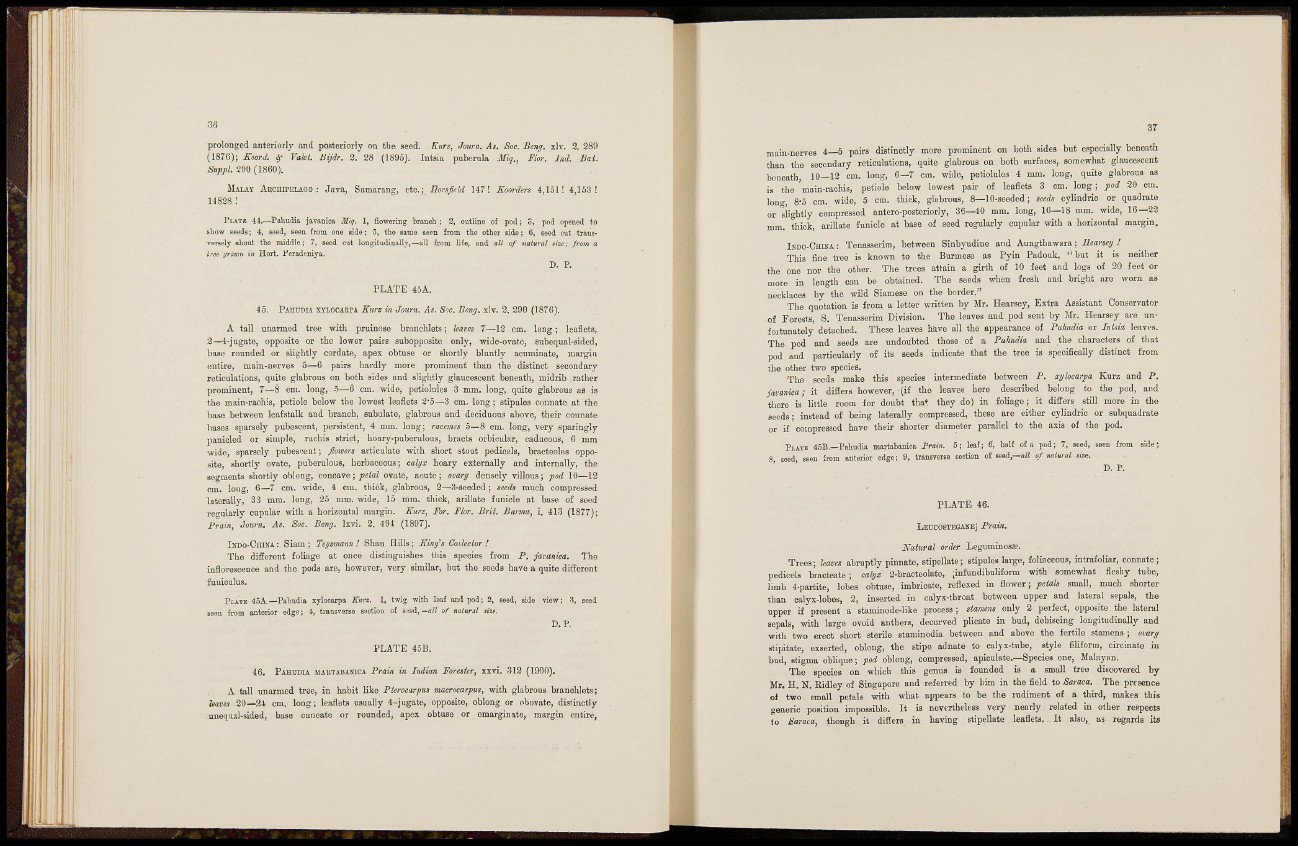
prolonged anteriorly and posteriorly on the seed. Eurz, Journ. As. Soc. Beng. xlv. 2, 289
(1876); Koord. Valet. Bijdr. 2. 28 (1895). Intsia pubenila Miq., Fior. 2nd. Bai.
.Suppl. 290 (1860).
MALAY ARCUIPELAGO : Java, Samarang, etc.; Horsfinld 147! Eoorders 4,151! 4,153!
U828 !
]'r.ATE 44.—Pahudia javanioa Miq. 1, floTveriiig branoli; 2, outline of pod; S, pod opened to
sliow seeds; 4, seed, seen from oae side; 5, the same seen from the other side; 6, seed cut traus-
Toraely about the middle; 7, seed out longitudinal!?,—ail from life, and all of natural she; from a
tree grown in Hort. ¿"eradeniya.
D. P.
P L A T E 45A.
45. PAUUDU SYLOCARPA Eurz in Journ. As. Soe. Bun^. xlv. 2. 2 9 0 (1876).
A tall unarmed tree with pruinose branchlets; leaves 7—12 cm. long; leaflets,
3—4-3ugate, opposite or the lower pairs subopposite only, wide-ovate, subequal-sided,
base rounded or slightly cordate, apex obtuse or shortly bluntly acuminate, margin
entire, main-nerves 5—6 pairs hardly more prominent than the distinct secondary
reticulations, quite glabrous on both sides and slightly glaueescent beneath, midrib rather
prominent, 7—8 cm. long, -5—6 cm. wide, petiolules 3 mm. long, quite glabrous as is
the main-rachis, petiole below the lowest leaflets 2-5—3 cm. long; stipules connate at the
base between leafstalk and branch, subulate, glabrous and deciduous above, their connate
bases sparsely pubescent, persistent, 4 mm. long; ractm.es 5—8 cm. long, very sparingly
panicled or simple, rachis sti-ict, hoary-puberulous, bracts orbicular, caducous, 6 mm
wide, sparsely pubescent; flotoers articulate with short stout pedicels, bracteoles opposite,
shortly ovate, puberulous, herbaceous; calyx hoary externally and internally, the
segments shortly oblong, concave; ovate, acute; ovary densely villous; pod 10—12
cm. long, 6—7 cm. wide, 4 cm. thick, glabrous, 2—3-seeded; seeds much compressed
laterally, 33 mm. long, 25 mm. wide, 15 mm. thick, arillate funicle at base of seed
regularly cupular with a horizontal margin. Eitrz, For. Flor. Brit. Burma, i. 413 (1877);
P°rain, Journ. As. Soc. Beng. Ixvi. 2. 494 (1897J.
INDO-CHINA: Siam; Teysmann ! Shan Hills; Eing^s Collector!
The different foliage at once distinguishes this species from F. javanica. The
inSorescence and the pods are, however, very similar, but the seeds have a quite different
funiculus.
PLATE 45A.—Paliudia sylocarpa Kurz. 1, twig with leaf auJ pod; 2, seed, side view; 3, seed
seen frocQ anterior edge; 4, transrerso saotion of seed, -all of natural sise.
P L A T E 45B.
46. PAHUDIA UAKTABANICA Praia in Indian Forester, xxvi. 312 (1900).
A tall unarmed tree, in habit like PteroC'irpus macrooarpus, with glabrous branchlets;
leaves 20—24 cm, long; leaflets usually 4-iugate, opposite, oblong or obovate, distinctly
•unequal-sided, base cuooate or rounded, apex obtuse or emarginate, margin entire,
main-nerves 4—5 pairs distinctly more prominent on both sides but especially beneath
than the secondary reticulations, quite glabrous on both surfaces, somewhat glaucescent
beneath, 10—12 cm. long, 6—7 cm. wide, petiolules 4 mm. long, quite glabrous as
is the 'main-rachis, petiole below lowest pair of leaflets 3 cm. long; pod 20 cm.
long, 8-5 cm. wide, 6 cm. thick, globrous, 8—10-aeeded; seeds cylindric or quadrate
or slightly compressed antero-posteriorly, 36—40 mm. long, 16—18 mm. wide, 16—22
mm. thick, arillate funicle at base of seed regularly cupular with a horizontal margin.
INDO-CHINA : Tenasserim, between Sinbyudine and Aungthawara; Eearsey !
This fine tree is known to the Burmese as Pyin Padouk, " b u t it is neither
the one nor the other. The trees attain a girth of 10 feet and logs of 20 feet or
more in length can be obtained. The seeds when fresh and bright are worn as
necklaces by the wild Siamese on the border."
The quotation is from a letter written by Mr. Heargey, Extra Assistant Conservator
of Forests, S. Tenasserim Division. The leaves and pod sent by Mr. Hearsey ai'e unfortunately
detached. These leaves have all the appearance of Pahudia or Intsia, leaves.
The pod and seeds are undoubted those of a Pahudia and the characters of that
pod and particularly of its seeds indicate that the tree is specifically distinct from
the other two species.
The seeds make this species intermediate between P. xyloearpa Kurz and P.
jnva-nica; differs however,-(if the leaves here described belong to the pod, and
there is' little room for doubt that they do) in foliage; it differs still more in the
seeds; instead of being laterally compressed, these are either cylindric or subquadrate
or if compressed have their shorter diameter parallel to the axis of the pod.
PiATB 45B.—Pahudia martabanica Prain. 5; leaf; 6', half of a pod; 7, seed, seen from side;
8 seed seen from anterior edge; 9, transverse section of s e e d , - a « of natural «tae.
P L A T E 46.
LEDCOSTEGANEJ Prain.
Natural oi-der
Trees; leaves abruptly pinnate, stipellate; stipules large, foliaceous, intrafoliar, connate ;
pedicels bracteate; calijx 2-bracteolate, .infundibuHform with somewhat fleshy tube,
limb 4-partite, lobes obtuse, imbricate, reflexed in flower; petals small, much shorter
than calyx-lobes, 2, inserted in calyx-throat between upper and lateral sepals, the
upper if present a staminode-like process; stamens only 2 perfect, opposite the lateral
sepals, with largo ovoid anthers, decurved plicate in bud, dehiscing longitudinally and
with two erect short sterile staminodia between and above the fertile stamens ; ovary
stipitate, exsertcd, oblong, the stipe adnate to calyx-tube, style fiUform, circinate in
bud, stigma oblique; pod oblong, compressed, apiculate.—Species one, Malayan.
The species on which this genus is founded is a small tree discovered by
Mr. H. N. Ridley of Singapore and referred by him in the field to Saraca. The presence
oi two small petals with what appears to be the rudiment of a third, makes tbia
generic position impossible. It is nevertheless very nearly related in other respects
to Saraca, though it differs in having stipellate leaflets... I t also, as regards Ita